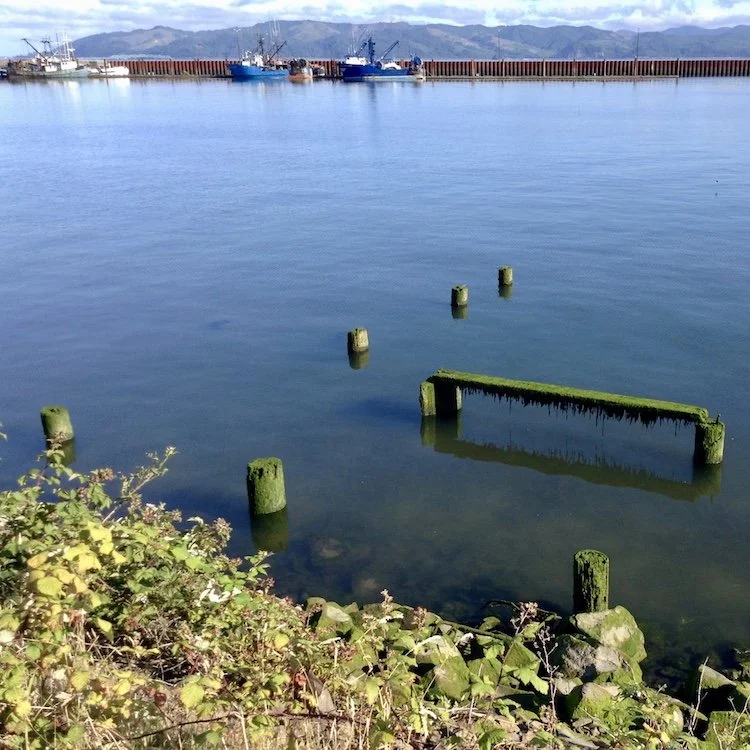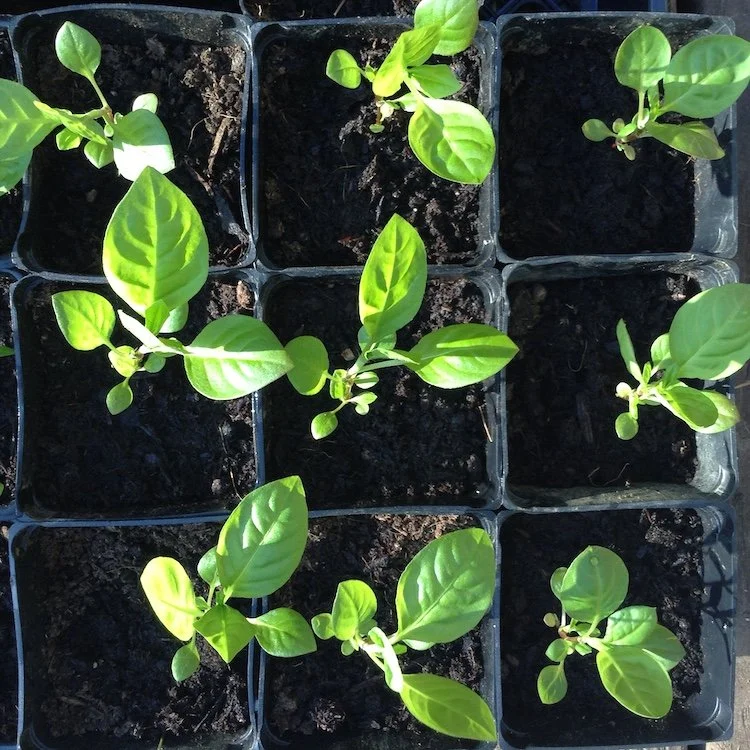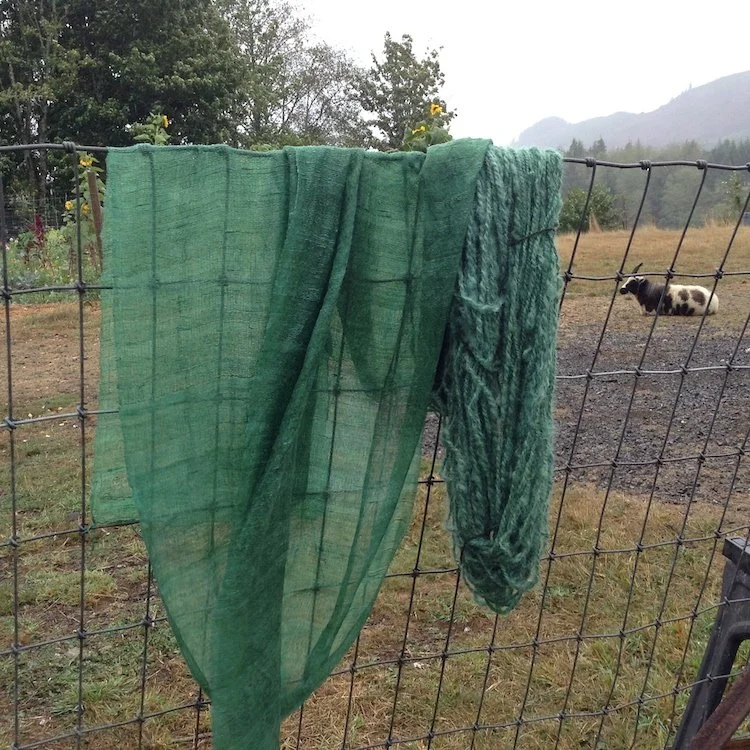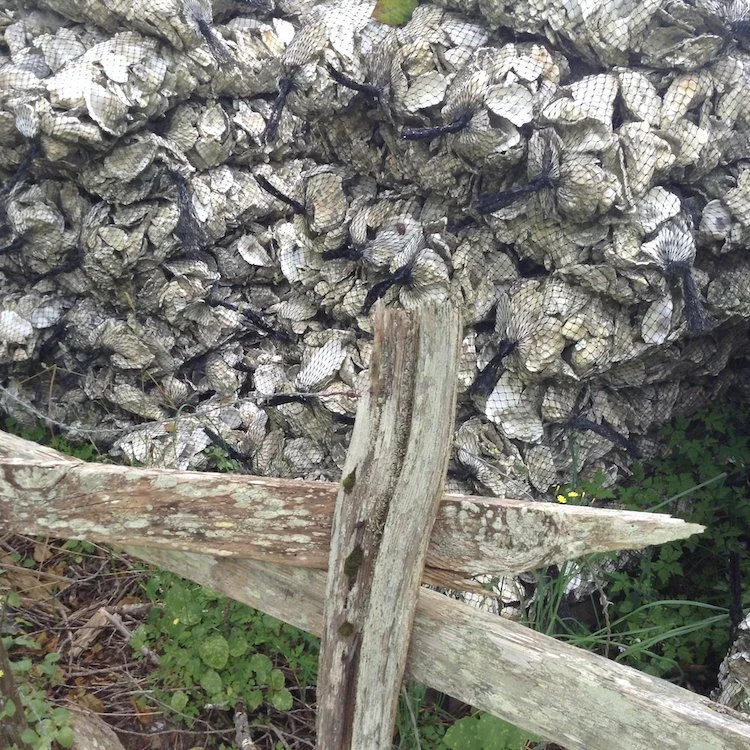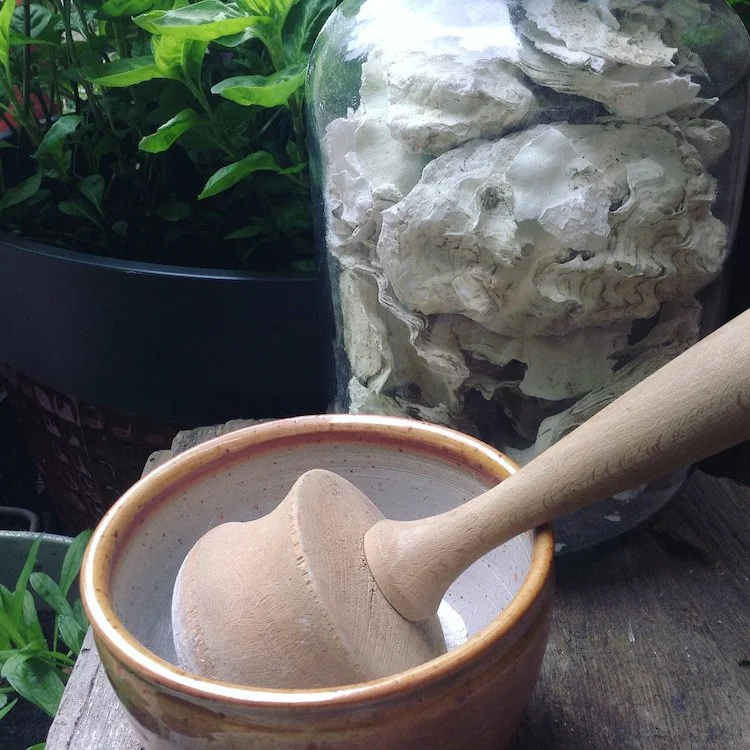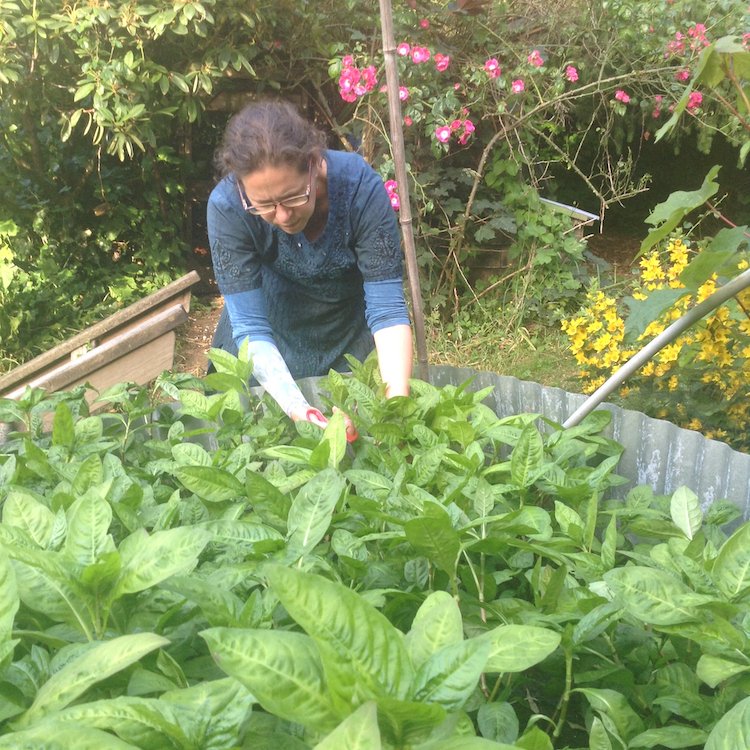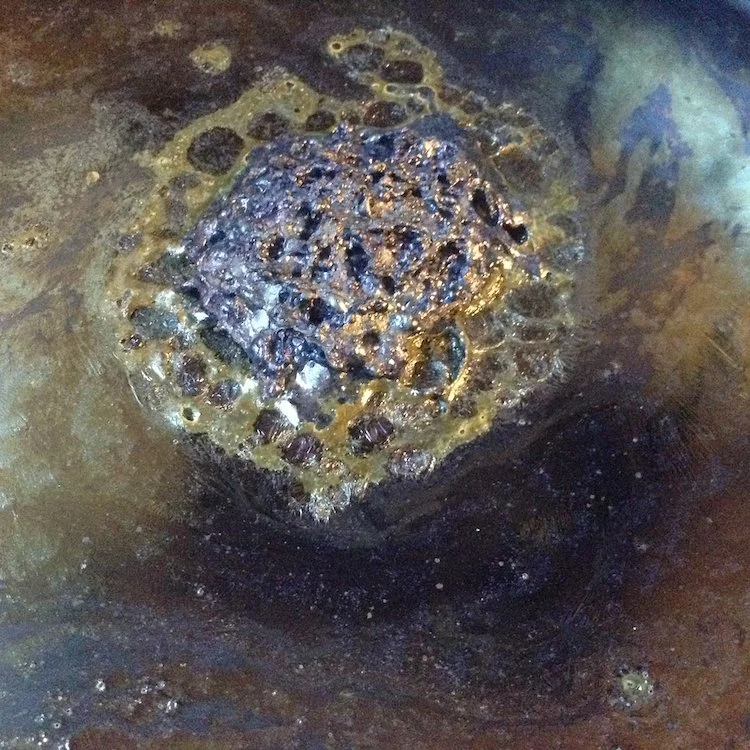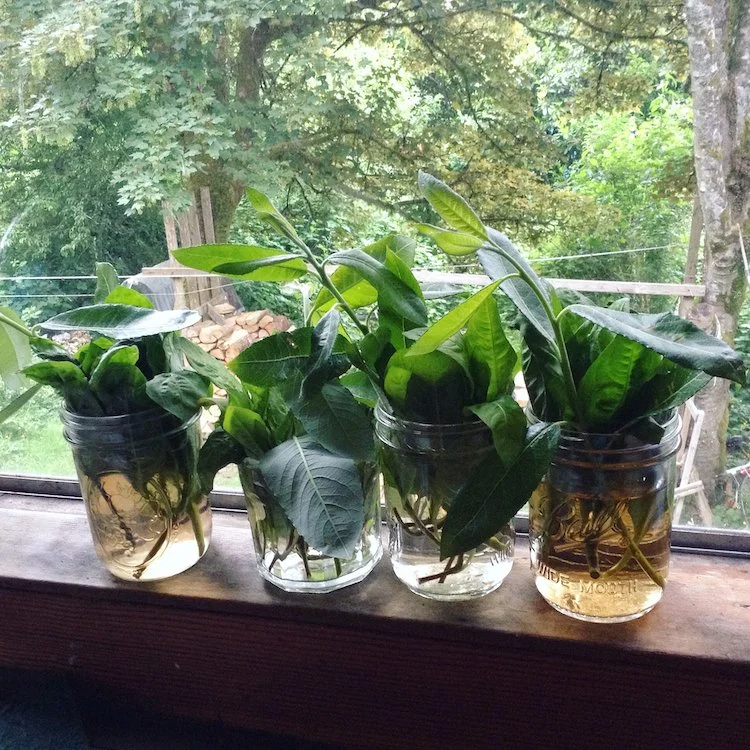A Fellowship of Blue - Local Indigo on the Oregon Coast
This first Appeared in the Spring of 2020 in the last issue of The Turkey Red Journal. This publication was published 1995-2020. Initially as a print publication, then online.
A Fellowship of Blue - Local Indigo on the Oregon Coast - Iris Sullivan Daire
I live in a temperate rainforest on the Oregon Coast, where there are many more days of mist, rain, and fog than of sunny skies. When the sun does come out, the landscape palette radically shifts away from the somber greys, browns and greens. When the glorious blue sky emerges from the clouds, and the river and sea reflect it back, there is nothing finer. It is a sort of alchemy, much as cloth emerging from the indigo vat is magically transformed. The radical color changes of the sky and landscape where I live may in part be what first drew me to working with indigo.
The very blue Columbia River in Astoria on a sunny morning
As a passionate natural dyer, finding connections between the land and the colors I make in my studio is important to me. Considerations around sustainability and how my work impacts the environment are vital. Creating an entirely local indigo vat has been a sort of personal Holy Grail since making my first fermentation vat in the early 1990’s, while studying at the University of Oregon. I have been pining for blue independence for over two decades.
The ideal for a truly local blue has felt decidedly out of reach. Several false assumptions, about the difficulty of growing any indigo bearing species here on the cool wet coast, held me back from even trying it at my shady hillside home. Woad, the cold tolerant indigo bearing species used by my Irish ancestors, is on the noxious non-native weed list for many Western states. It is actually illegal to grow woad here in Oregon. So for years I continued to use indigo powder imported from tropical India in my work.
Persicaria tinctoria seedlings eager to go in the ground
Everything changed in 2017 when a friend, Brittany Boles, shared a flat of seedlings with artist Kestrel Gates of HiiH Lights and myself. These were Japanese Indigo, Persicaria tinctoria. Brittany had caught the fever to grow indigo in 2016 at Vibrant Valley Farm on Sauvie Island, which is in the Columbia River near Portland, Oregon, about 80 miles upriver from us. Kara Gibbs, the farmer at Vibrant Valley, started growing indigo from seeds she received from Rowland Ricketts.
Enthusiasm for growing indigo really is like a fever. Home grown blue pigment inspires a wild joy in everyone I know who has grown it. With good reason, all the magic of dyeing with indigo is amplified when you have grown it yourself. Kestrel grew out forty plants in 2017. Over the summer we harvested them several times for fresh leaf dyeing. For the final fall harvest we made our first attempt at pigment extraction, which yielded enough indigo for a five gallon henna vat that Kestrel used to dye her handspun wool, and a bit to paint onto the handmade paper lights she and her husband, Lâm Quàng, create.
Dyeing with the fresh indigo leaves creates greens and turquoise on silk and wool.
By early spring of 2018 Kestrel and I were nearly as indigo ambitious as Brittany. We started hundreds of plants from both our own saved seeds, and additional seed sourced from Graham Keegan. (Keegan is definitely another vector in the epidemic of indigo growing fever sweeping the nation. Read his amazing and informative website at your own risk…) For her dye garden Brittany partners with North Fork 53 Retreat in Nehalem, Oregon. (They also grow tea there.) In 2018 Brittany once again had the largest planting and biggest indigo pigment yield in the county. All three of us shared seedlings, and later cuttings, with yet more friends. Ultimately at least 10 people grew small indigo crops in rural Clatsop County from plants provided by the three of us in 2018.
By the time we had planted out the little seedlings in June, we were making plans for the first annual IndigoFest to celebrate Oregon Coast grown indigo in August. The event was hosted at North Fork 53, and was an entire day devoted to indigo harvesting and dyeing with our growing community of indigo enthusiasts.
Instructors at IndigoFest included: Brittany Boles who taught fresh leaf dyeing and extraction; Fiber artist Kyla Sjogren who led a dye session highlighting both the henna vat and an Iron Vat; and myself. I had the privilege of presenting the Coastal Vat, sourced entirely from local ingredients. It was the fulfillment of a decades long dream.
Iris Sullivan Daire, Brittany Boles, and Kyla Sjogren, compare their blue hands after IndigoFest 2018.
To meet the challenge of creating a modern vat from local materials required some research. The First Peoples of the Pacific Northwest have no known indigo tradition, so there are no ethnobotanical clues to be found to guide the process of a local vat from that direction.
We didn't have near enough time or expertise to even try tackling a traditional Japanese sukumo vat. So that was out too.
Not having a historical recipe to recreate encouraged research and experimentation. The first principles of an indigo vat are actually pretty simple. Despite what it might seem like considering the huge diversity of effective historical methods for both extraction and dyeing with indigo. There are many right ways to make a vat. Modern chemistry clarifies it by identifying the three functional parts that must be present in every vat as:
Indigo pigment
A reduction agent
An alkali to raise pH
Local indigo pigment would eventually come from our still young and tender plants. Finding the best locally sourced alkali and reduction agents needed to be sorted out first.
While our plants grew I worked on obtaining a local alkali source. It was needed for two things; first as a flocculant, to assist the precipitation of indigo pigment during the extraction process, and second to raise the pH of the vat into the right zone to dissolve the reduced indigo.
Bagged Oyster shells on the side of the road near an oyster processing plant
There are a variety of raw substances which have provided the alkali influence for indigo vats through time: urine, wood ash, seaweed, limestone, and oyster shells...
When my sons were little I tried my hand at a Sig vat using their urine. And while it did work well, especially on wool, I decided that a stinky fermented urine vat was probably not for the uninitiated indigo dyers we expected to sign up for our first IndigoFest.
Sample dip of local wool felt in the Coastal Vat
We heat our house with wood, and I have used wood ash lye for both soap making and indigo vats. However, I had concerns about trying it for the indigo extraction process. I also didn’t think that burning seaweed to make soda ash sounded practical, especially as soda ash also doesn't work well as a flocculant. So ixnay on seaweed and wood ash lye. Of all the other alkali options, oyster shells seemed the best, and most iconic, choice for our purposes.
The Oregon Coast is known geologically for rain washed acidic soils and basalt rock, not limestone. However, we do have oyster farms, and they end up with piles of oyster shells, made almost entirely of calcium carbonate, CaCO3, the same substance as limestone. It was quite easy to come up with a five gallon bucket of oyster shells. Though I like that the ones we used came from the 75th birthday potluck of a neighbor.
When CaCO3 - from limestone or oyster shells, is heated to around 900℃ the calcium carbonate is transformed, in a process called Calcining, into calcium oxide, CAO (AKA quicklime.) When that CAO is slaked, by adding water, the resulting liquid is known as lime water, a slurry of “slaked lime” Calcium Hydroxide, Ca(OH)2 and water, H2O. Lime water just so happens to be ideal for both extracting indigo pigment and raising the pH of an indigo vat.
Armed with this basic understanding of the lime cycle, and a bucket of Willapa Bay birthday oysters we now had the option of making what we needed from local materials using an ancient technology.
Crushing up the cooked oyster shell lime
A friend, potter Richard Rowland, graciously cooked the oyster shells into lime for us using his kiln. During the firing the shells were placed inside a large unglazed pot Richard had made. The hard shells were rendered by the heat into a beautiful crumbly white texture. The transformed shells are easily crushed into powder using a mortar and pestle. By simply adding the powder to rain water, we were in the local lime business.
We got lime just in time, as our plants had finally matured enough to harvest, and we were ready to refine the pigment. (If you are interested in the extraction process then John Marshall’s book, Singing the Blues, is a wonder.)
The Persicaria tinctoria grew very well even in my mostly shady yard
In preparation for IndigoFest I used the entirety of pigment extracted from my little dye garden’s first cutting. It was not enough to make a very big vat. Thankfully Brittany had quite a bit more from her plants, which she donated to the cause.
Having secured both an alkali and pigment, I was ready to address the final piece of our local vat puzzle, finding an agent of reduction. A reduction agent works with the alkali to bind up any free oxygen molecules in the vat liquid, and facilitates the transformation of the insoluble blue indigo pigment, the Indigotin molecule, into its nearly colorless, and soluble, leuco form. It is this dance into solubility that allows the leuco indigo to nestle into any materials put into the vat. Then once outside the vat, the indigo within the cloth is oxidized again and reverts to blueness.
Options for reduction agents are even more diverse than the choices for an alkali. From strong chemicals like the Sodium Hydrosulfite of industry, to rice bran used to feed a fermentation vat, and seemingly countless other things. It can all feel a little daunting. Luckily Michel Garcia’s Organic Vat formula, using fruit sugars as the reduction agent, was just the jumping off point we needed for our experiments. The best bet for a local reducer was to explore available sources of fructose.
I spent June and July making little one quart test vats with various foraged and harvested ingredients. I had some success with wild cherries, over ripe zucchini and pollen laden wild fennel flowers. Golden beets, frozen huckleberries, windfall apples, and ripening fennel seed heads - with no pollen, were all failures. Finally a clear winner of all the trials emerged, the dark ripe berries of salal, Gaultheria shallon.
Ripe Berries of the Salal Plant, Gualtheria shallon (Photo Credit Wikipedia Commons)
Salal was perfect from several fronts. It is native to the west coast, where the mild sweet berries are enjoyed by hikers and wild birds alike. They are low in acid and also exceptionally rich in antioxidants (read anti-oxygen). Which means that the berries contain more than one useful reduction mechanism.
With all three parts identified: Lime, Indigo and the Salal, the time had come to assemble the Coastal Indigo Vat!
A few days prior to Indigo Fest I cooked up roughly a gallon of salal berries still on the stems with plenty of rainwater. This was brought to a simmer for about 30 minutes, turning into a sort of dark berry “soup.”. After cooling it down to about 85°C the berry mash was strained out and set aside. The warm and fragrant salal liquid was put into the 3 gallon vat container to form the base for the Coastal Vat. The set aside berry mash was subsequently heated with fresh water to make a second batch of berry soup. This was saved in the fridge and used to “feed” the vat later.
Scrapping the freshly filtered homegrown indigo pigment paste into jars
To the salal soup I stirred in enough of the homemade lime water to bring the pH up to 10. The final addition was the precious homegrown indigo pigment. Since our pigment had never been dried, wetting it out was unnecessary. I simply stirred a bit more water into the paste before pouring it into the vat. The mixture was given a good stir accompanied by singing. Then covered with a lid and blankets to keep warm, giving all three parts a chance to commingle and get friendly.
After several hours I opened up the lid to check for vat development. It showed a distinct coppery surface sheen with the beginnings of a bubbly flower. It also smelled really good. More stirring and resting followed. It is worth noting that the color of the vat liquid never became the yellow hue often seen in some types of vats. I suspect that the enormous amount of anthocyanins in the salal berries, or tannins from the stems, kept the vat liquid darker than other vats I have worked with.
Beginnings of a copper sheen on the surface of a new indigo vat is a sign that things are starting to work
The next day the first cotton test strip was dipped into the fresh vat. It emerged a golden color, and once removed quickly bloomed into the hoped for indigo blue! Yay! Quite a bit of excitement in the studio, let me tell you.
The vat seemed perky enough to dye a small skein of hand-spun angora from Clancy, my neighbor's rabbit, so I did. After which I gave the vat a pinch of the oyster lime, and some of the warmed up salal "soup". Another good stir and it was put to bed for the night. I went to sleep really happy too.
By morning the flower was very robust, and the vat was able to travel down to Nehalem for Indigo Fest without incident. Participants dyed cotton samples and cup cozies made with felted wool from some of Kestrel's Jacob sheep. We used the blue bunny yarn I had dyed to wrap bracelets on our wrists as part of the closing ceremony for the event - connecting ourselves symbolically to indigo dyers everywhere.
The Coastal Salal Vat with its frothy flower all packed up to travel.
Dyeing with a vat of home grown and gathered ingredients, brought up such immense gratitude to me for all my indigo teachers, including the generous elder dyer I was fortunate to meet in Laos while visiting there with my mentor Michelle Wipplinger in 2005. The bunny wool bracelets were a nod to the cotton string bracelets we received on that trip during a welcome ceremony from the weavers and dyers of Laha Nam. Dyeing with my own pigment also brings a wonderful sense of connection to my ancestors who were weaving and dyeing with woad in Ireland, and to all the many indigo dyers of the past, present, and future.
While the quest for a Coastal Indigo Vat started with the goal of blue independence, it ended up as blue interdependence. It is a splendid collaboration, and I can't wait to do more.
Yay indigo dyers near and far! Yay Farmers! Yay Salal! Yay Oysters! Yay Japanese Indigo! Yay Sheep! Yay Bunny! & Yay Community!
Cut stems of Persicaria tinctoria grow roots very easily, allowing you to share plants with friends every time you harvest.
P.S. In September of 2019 the Second Annual IndigoFest happened at North Fork 53, this time as a three day event. Brittany and I were joined by indigo grower Kara Gibbs of Vibrant Valley Farm as workshop facilitators. A much bigger 100% local Community Vat was at the center of all three days. The vat used a combination of foraged Salal berries, and cooked up muskmelons grown by a local farmer, as reducers in the 14 gallon vat. The 700 grams of indigo paste used came from five growing locations. Truly an experience of interdependence. For IndigoFest 2020 we hope to include pigment from even more growers in our community vat of Oregon Coast blue.
In 2018 we created our first 100% local vat. We were only able to do so by standing on the shoulders of giants. A project made possible by the immense dedication of centuries of dyers in many places. A beautiful blue web. It feels a privilege to be even a small part of it. May the renaissance of indigo blue currently happening around the world bring peace and healing to all.
( BTW, I am quite certain that most participants of both the 2018 & 2019 IndigoFests were infected with the fever to grow indigo, and even more Japanese indigo plants will be grown here on the Oregon Coast in the future.)
****
Bibliography
Books
Balfor-Paul, Jenny, 1998. Indigo. British Museum Press London, Great Britain
Böhmer, Harald, 2002. Koekboya Natural Dyes and Textiles. REHÖB-Verlag Ganderkeses, Germany
Boutrup, Joy & Ellis, Catherine, 2019. The Art and Science of Natural Dyes: Principles, Experiments, and Results. Schiffer Publishing Ltd., Atglen, Pennsylvania USA
Cardon, Dominique, 2007. Natural Dyes. Archetype Publications, London Great Britain
Callender, Jane, 2017 Stitched Shibori: Techniques, innovation, pattern, design, Search Press Ltd. Turnbridge Wells, Kent, Great Britain
Goodwin, Jill, 2003. A Dyer’s Manual - Second Edition, Ashmans Publications, Newlodge, Southfield Hessle, England
Liles, J.N. 1990. The Art and Craft of Natural Dyeing. University of Tennessee Press, Knoxville TN USA
Marshall, John, 2018. Singing the Blues. Saint Titus Press, Covelo, California USA
Miller, Dorothy, 1984. Indigo from Seed to Dye. Indigo Press, Aptos California USA
Räisänen, Riikka; Primetta, Anja; Niinimäki, Kirsa, 2016. Dyes from Nature. English edition, Archetype Editions, London (2015 Finnish Language Edition Maahenki Oy, Helsinki Finland)
Sandberg, Gösta, 1989. Indigo Textiles Technique and History. Lark Books, Asheville,North Carolina USA
Wada, Yoshiko Iwamoto, 1999 Shibori: The inventive Art of Japanese Shaped Resist Dyeing. Kodansha International, New York, New York USA
DVDs
Garcia, Michel, 2012 - 2019. Natural Dye Workshop with Michel Garcia I - IV Slow Fibers Studios Berkeley California, USA
My Teachers
Barbara Setsu Pickett
Marilyn Roberts
Keiko Yamanouchi
Michele Wipplinger
The dyers of Laha Laos
Michel Garcia
…and the Students in my workshops, who ask questions that inspire learning.
Author Bio
Iris Sullivan Daire is a fiber artist and workshop facilitator. She holds a BFA from the University of Oregon with a focus on natural dyes. Iris lives with her family in Astoria, Oregon.
Her website: www.dreambirdstudio.com
Info about the collaboration of Oregon Coast blues: www.Indigofest.org

